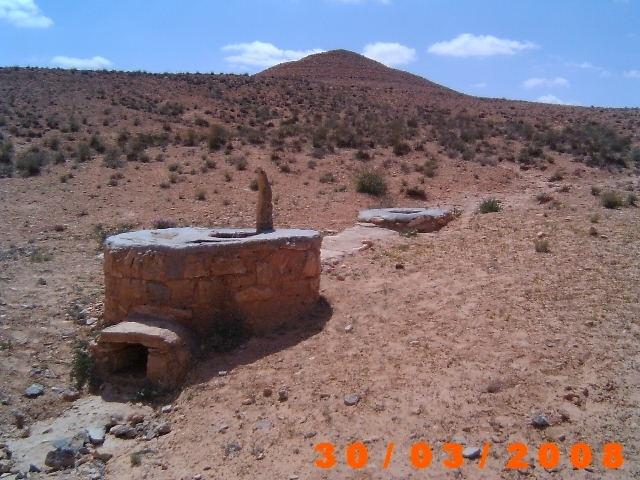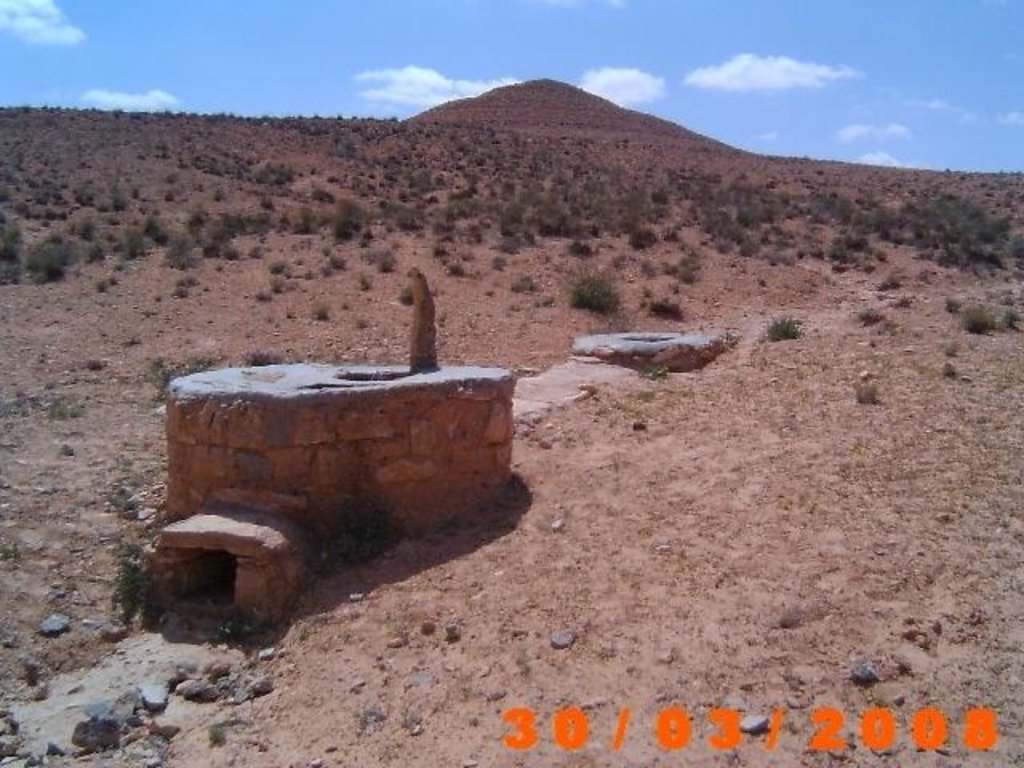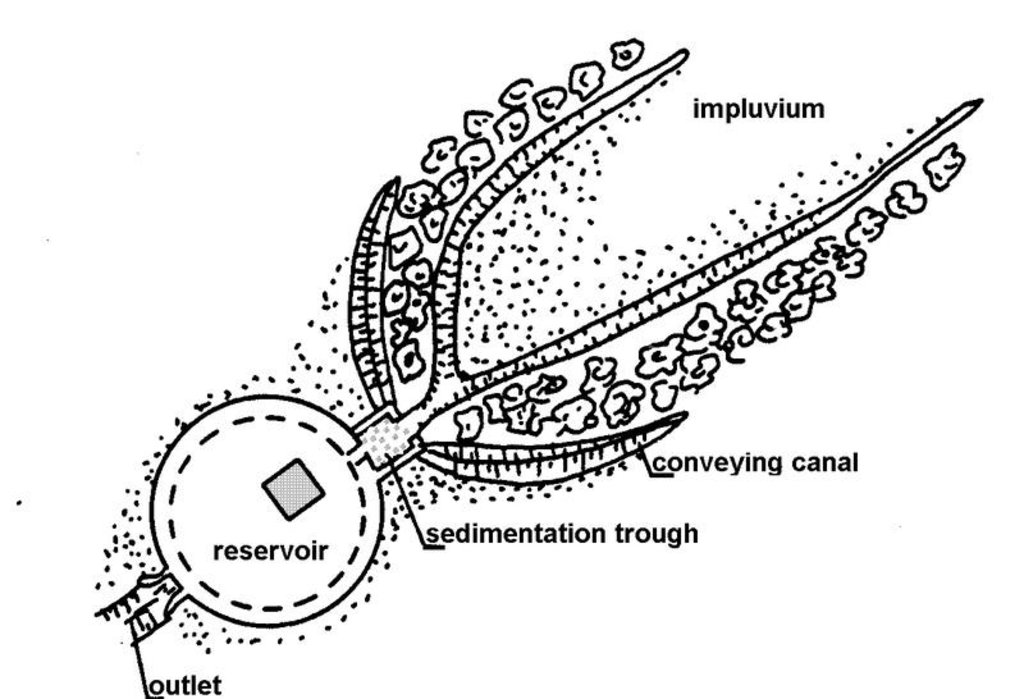Cistern [突尼斯]
- 创建:
- 更新:
- 编制者: Mongi Ben Zaied
- 编辑者: –
- 审查者: Fabian Ottiger
Majen / Majel / fasquia (Ar)
technologies_1413 - 突尼斯
查看章节
全部展开 全部收起1. 一般信息
1.2 参与该技术评估和文件编制的资源人员和机构的联系方式
关键资源人
SLM专业人员:
Sghaier Mongi
Institut des Régions Arides IRA
4119 Medenine, Tunisia
突尼斯
SLM专业人员:
Chniter Mongi
Commissariats Régionaux au Développement Agricole CRDA
4100 Medenine, Tunisia
突尼斯
SLM专业人员:
有助于对技术进行记录/评估的机构名称(如相关)
Institut des Régions Arides de Médenine (Institut des Régions Arides de Médenine) - 突尼斯有助于对技术进行记录/评估的机构名称(如相关)
Commissariats Régionaux au Développement Agricole (CRDA) - 突尼斯1.3 关于使用通过WOCAT记录的数据的条件
(现场)数据是什么时候汇编的?:
31/01/2009
编制者和关键资源人员接受有关使用通过WOCAT记录数据的条件。:
是
2. SLM技术的说明
2.1 技术简介
技术定义:
Cisterns are reservoirs used for storing rainfall and runoff water for multiple purposes: drinking, animal watering and supplemental irrigation.
2.2 技术的详细说明
说明:
Cisterns were traditionally used to provide drinking water. In the cistern system, runoff water is collected and stored in stone-faced underground cisterns, of various sizes, called majel (private reservoirs) and fesquia (communal reservoirs). Basically, a cistern is a hole dug in the ground and lined with a gypsum or concrete coating, in order to avoid vertical and lateral infiltration. Each unit consists of three main parts: the impluvium, the sediment settlement basin, and the storage reservoir. The impluvium is a sloping piece of land delimited by a diversion channel (hammala).
Purpose of the Technology: It is estimated that a tank with a capacity of 35 m3 can meet the annual water needs of a family and its livestock (Ennabli, 1993).
Establishment / maintenance activities and inputs: In flat areas, where it is possible also to exploit floods via a diversion dyke, one also finds artificially paved runoff areas. A small basin before the entrance of the cistern allows the sedimentation of runoff loads. This improves the stored water quality and reduces maintenance costs. Big cisterns have, in addition to the storage compartment, a pumping reservoir from which water is drawn (Ouessar, 2007).
Natural / human environment: Small private and communal cisterns (5 to 200 m3) and big cisterns (up to 70,000 m3), mainly built during the Roman and Arab-Muslim eras, can be found throughout the water-deficient zone south of the 400-mm isohyet .
2.3 技术照片
2.5 已应用该技术的、本评估所涵盖的国家/地区/地点
国家:
突尼斯
区域/州/省:
Medenine
有关地点的进一步说明:
Medenine nord
Map
×2.6 实施日期
如果不知道确切的年份,请说明大概的日期:
- 50多年前(传统)
2.7 技术介绍
详细说明该技术是如何引入的:
- 作为传统系统的一部分(> 50 年)
3. SLM技术的分类
3.2 应用该技术的当前土地利用类型

混合(作物/放牧/树木),包括农林

其它
注释:
Major land use problems (compiler’s opinion): Runoff loss
Major land use problems (land users’ perception): Water loss
3.3 有关土地利用的更多信息
每年的生长季节数:
- 1
具体说明:
Longest growing period in days: 180Longest growing period from month to month: Oct - Apr
3.4 该技术所属的SLM组
- 集水
3.5 技术传播
具体说明该技术的分布:
- 均匀地分布在一个区域
如果该技术均匀地分布在一个区域上,请注明覆盖的大致区域。:
- 10-100 平方千米
3.6 包含该技术的可持续土地管理措施

结构措施
- S11:其它
注释:
Main measures: structural measures
3.7 该技术强调的主要土地退化类型

水质恶化
- Ha:干旱化
注释:
Main type of degradation addressed: Ha: aridification
Main causes of degradation: droughts
3.8 防止、减少或恢复土地退化
具体数量名该技术与土地退化有关的目标:
- 减少土地退化
注释:
Main goals: mitigation / reduction of land degradation
4. 技术规范、实施活动、投入和成本
4.1 该技术的技术图纸
4.2 技术规范/技术图纸说明
Components of the cistern system.
south east Tunisia
Date: January 2009
Technical knowledge required for field staff / advisors: low
Technical knowledge required for land users: low
Main technical functions: water harvesting / increase water supply
Structural measure: Reservoir
Depth of ditches/pits/dams (m): 4-10
Width of ditches/pits/dams (m): 2-4
Construction material (stone): Stone
Construction material (concrete): coating
For water harvesting: the ratio between the area where the harvested water is applied and the total area from which water is collected is: 1:4
4.3 有关投入和成本计算的一般信息
其它/国家货币(具体说明):
TND
注明美元与当地货币的汇率(如相关):1美元=:
1.3
注明雇用劳工的每日平均工资成本:
10.00
4.4 技术建立活动
| 活动 | 措施类型 | 时间 | |
|---|---|---|---|
| 1. | Pit digging | 结构性的 | |
| 2. | Coating | 结构性的 |
4.5 技术建立所需要的费用和投入
| 对投入进行具体说明 | 单位 | 数量 | 单位成本 | 每项投入的总成本 | 土地使用者承担的成本% | |
|---|---|---|---|---|---|---|
| 劳动力 | Labour | ha | 1.0 | 250.0 | 250.0 | |
| 施工材料 | ha | 1.0 | 150.0 | 150.0 | ||
| 技术建立所需总成本 | 400.0 | |||||
注释:
Duration of establishment phase: 1 month(s)
4.6 维护/经常性活动
| 活动 | 措施类型 | 时间/频率 | |
|---|---|---|---|
| 1. | Desilting | 结构性的 | Yearly |
| 2. | Repairs | 结构性的 | Each 3-5 years |
4.7 维护/经常性活动所需要的费用和投入(每年)
| 对投入进行具体说明 | 单位 | 数量 | 单位成本 | 每项投入的总成本 | 土地使用者承担的成本% | |
|---|---|---|---|---|---|---|
| 劳动力 | Labour | ha | 1.0 | 80.0 | 80.0 | |
| 施工材料 | ha | 1.0 | 50.0 | 50.0 | ||
| 技术维护所需总成本 | 130.0 | |||||
5. 自然和人文环境
5.1 气候
年降雨量
- < 250毫米
- 251-500毫米
- 501-750毫米
- 751-1,000毫米
- 1,001-1,500毫米
- 1,501-2,000毫米
- 2,001-3,000毫米
- 3,001-4,000毫米
- > 4,000毫米
农业气候带
- 干旱
Thermal climate class: subtropics
5.2 地形
平均坡度:
- 水平(0-2%)
- 缓降(3-5%)
- 平缓(6-10%)
- 滚坡(11-15%)
- 崎岖(16-30%)
- 陡峭(31-60%)
- 非常陡峭(>60%)
地形:
- 高原/平原
- 山脊
- 山坡
- 山地斜坡
- 麓坡
- 谷底
垂直分布带:
- 0-100 m a.s.l.
- 101-500 m a.s.l.
- 501-1,000 m a.s.l.
- 1,001-1,500 m a.s.l.
- 1,501-2,000 m a.s.l.
- 2,001-2,500 m a.s.l.
- 2,501-3,000 m a.s.l.
- 3,001-4,000 m a.s.l.
- > 4,000 m a.s.l.
5.4 水资源可用性和质量
水质(未处理):
良好饮用水
5.6 应用该技术的土地使用者的特征
非农收入:
- > 收入的50%
相对财富水平:
- 贫瘠
- 平均水平
个人或集体:
- 个人/家庭
性别:
- 男人
说明土地使用者的其他有关特征:
Land users applying the Technology are mainly common / average land users
Population density: 10-50 persons/km2
Annual population growth: 0.5% - 1%
10% of the land users are rich and own 15% of the land.
70% of the land users are average wealthy and own 75% of the land.
20% of the land users are poor and own 10% of the land.
5.7 应用该技术的土地使用者拥有或租用的平均土地面积
- < 0.5 公顷
- 0.5-1 公顷
- 1-2 公顷
- 2-5公顷
- 5-15公顷
- 15-50公顷
- 50-100公顷
- 100-500公顷
- 500-1,000公顷
- 1,000-10,000公顷
- > 10,000公顷
这被认为是小规模、中规模还是大规模的(参照当地实际情况)?:
- 小规模的
5.8 土地所有权、土地使用权和水使用权
土地所有权:
- 社区/村庄
- 个人,有命名
土地使用权:
- 社区(有组织)
- 个人
用水权:
- 社区(有组织)
- 个人
5.9 进入服务和基础设施的通道
健康:
- 贫瘠
- 适度的
- 好
教育:
- 贫瘠
- 适度的
- 好
技术援助:
- 贫瘠
- 适度的
- 好
就业(例如非农):
- 贫瘠
- 适度的
- 好
市场:
- 贫瘠
- 适度的
- 好
能源:
- 贫瘠
- 适度的
- 好
道路和交通:
- 贫瘠
- 适度的
- 好
饮用水和卫生设施:
- 贫瘠
- 适度的
- 好
金融服务:
- 贫瘠
- 适度的
- 好
6. 影响和结论性说明
6.1 该技术的现场影响
社会经济效应
生产
畜牧生产
水资源可用性和质量
饮用水的可用性
社会文化影响
SLM/土地退化知识
冲突缓解
注释/具体说明:
negligible (0-5%)
Improved livelihoods and human well-being
生态影响
水循环/径流
水量
水的回收/收集
土壤
土壤覆盖层
土壤流失
减少气候和灾害风险
风速
6.3 技术对渐变气候以及与气候相关的极端情况/灾害的暴露和敏感性(土地使用者认为的极端情况/灾害)
渐变气候
渐变气候
| 季节 | 气候变化/极端天气的类型 | 该技术是如何应对的? | |
|---|---|---|---|
| 年温度 | 增加 | 好 |
气候有关的极端情况(灾害)
气象灾害
| 该技术是如何应对的? | |
|---|---|
| 局地暴雨 | 好 |
| 局地风暴 | 好 |
气候灾害
| 该技术是如何应对的? | |
|---|---|
| 干旱 | 不好 |
水文灾害
| 该技术是如何应对的? | |
|---|---|
| 比较和缓的(河道)洪水 | 好 |
其他气候相关的后果
其他气候相关的后果
| 该技术是如何应对的? | |
|---|---|
| 缩短生长期 | 好 |
6.4 成本效益分析
技术收益与技术建立成本相比如何(从土地使用者的角度看)?
短期回报:
积极
长期回报:
积极
技术收益与技术维护成本/经常性成本相比如何(从土地使用者的角度看)?
短期回报:
积极
长期回报:
积极
6.5 技术采用
注释:
30% of land user families have adopted the Technology with external material support
70% of land user families have adopted the Technology without any external material support
There is a moderate trend towards spontaneous adoption of the Technology
6.7 该技术的优点/长处/机会
| 土地使用者眼中的长处/优势/机会 |
|---|
| Availability of water for multiple purposes |
| 编制者或其他关键资源人员认为的长处/优势/机会 |
|---|
| Increased availability of water especially in remote areas |
6.8 技术的弱点/缺点/风险及其克服方法
| 编制者或其他关键资源人员认为的弱点/缺点/风险 | 如何克服它们? |
|---|---|
| Creation of degradation hot spots around animal watering points. | Multiplication of watering points. |
7. 参考和链接
7.2 参考可用出版物
标题、作者、年份、ISBN:
Ben Mechlia, N., Ouessar, M. 2004. Water harvesting systems in Tunisia. In: Oweis, T., Hachum, A., Bruggeman, A. (eds). Indigenous water harvesting in West Asia and North Africa, , ICARDA, Aleppo, Syria, pp: 21-41.
可以从哪里获得?成本如何?
IRA, ICARDA
标题、作者、年份、ISBN:
Chahbani, B. 2004. Technical innovations to optimize water harvesting, conservation and use for a sustainable development of rainfed agriculture in arid zones. Options Méditerranéennes, 60: 73-78.
可以从哪里获得?成本如何?
IRA, CIHEAM
标题、作者、年份、ISBN:
El Amami, S. 1984. Les aménagements hydrauliques traditionnels en Tunisie. Centre de Recherche en Génie Rural (CRGR), Tunis, Tunisia. 69 pp.
可以从哪里获得?成本如何?
IRA, CRGER
标题、作者、年份、ISBN:
Ennabli, N. 1993. Les aménagements hydrauliques et hydro-agricoles en Tunisie. Imprimerie Officielle de la République Tunisienne, Tunis, 255 pp.
可以从哪里获得?成本如何?
IRA, INAT
标题、作者、年份、ISBN:
Ouessar M. 2007. Hydrological impacts of rainwater harvesting in wadi Oum Zessar watershed (Southern Tunisia). Ph.D. thesis, Faculty of Bioscience Engineering, Ghent University, Ghent, Belgium, 154 pp.
可以从哪里获得?成本如何?
IRA
链接和模块
全部展开 全部收起链接
无链接
模块
无模块





